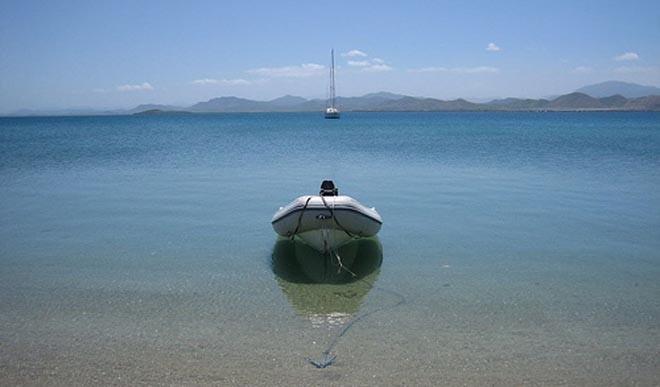Caring for your inflatable dinghy - Ten Top Tips
by Des Ryan on 15 Sep 2013

The dinghy - the cruising sailor’s favourite companion SW
Inflatable dinghies are the most popular transport for cruising sailors - they are fairly easy to maintain and can be deflated or stored easily on the deck during long journeys. However, even though they are easier to maintain than fibreflass dinghies, they still require care to keep them in the best shape for the longest possible time. Here are Ten Top Tips to keep your dinghy in great condition:
1. Think of the UV:
Dinghies that are in use often have to suffer a lot of sunlight. Either purchase a hyperlon dinghy for the way it stands up to UV light destruction, or, if you have a PVC dinghy make a canvas sleeve. Depending on where and when you sail, stowing the dinghy out of the sunlight will extend its life. However, make sure that the dinghy doesn't get too cold - near freezing or freezing temperatures can degrade the material.
2. Keep it inflated whenever possible:
To allow an inflatable to languish in a deflated state promotes seam separation, chafing and abrasion. An inflatable should be kept pumped to the pressure recommended by the manufacturer, and, since many inflatables lose air over time, they should be inspected and topped up.
3. The 'old carpet' trick:
Carrying a piece of old carpet on board can be useful in protecting your inflatable if you have to tie up to a barnacle-infested old dock, seawall or piling. Simply drape the carpet over the shore-side tube before tying up.
4. Washing:
If possible, wash your dinghy with fresh water and get the trapped sand and salt out of it when you have finished using it. Even wiping it with a wet cloth will make a difference. If you must use soap, make it a mild dish soap.
5. Avoiding cleaners:
Do not use multi-purpose cleaners, shiners, or any other commercial products on your inflatable dingy, merely wash it with clean water water.
6. Correct inflating procedure:
When inflating your raft or boat fill each air chamber in a clockwise pattern around the boat, just until the craft takes shape. Then work your way back around the boat filling the chambers to the pressure level indicated for that particular boat. Don't overfill - when finished there should be just a small amount of 'give' to a thumb press.
7. Hot air expands:
Be aware that air expands when hot. If you fill the dinghy in cool air and then experience a marked upwards temperature change, give your dinghy the thumb test again and let some air out until the amount of 'give' returns to normal.
8. Be conscious of sharp objects:
Dinghies do not like sharp objects or continual chafe in one area. Be careful when knives or fishing hooks, and any other object that could puncture the skin. Avoid dragging the boat over rocks and shells when landing on a beach and keep that piece of carpet at the ready if you are approaching a any dock that appears barnacled.
9. Chafing:
Chafing can also be a source of trouble on a dinghy. Regularly check the surface of the dinghy for possible beginnings of chafe. This can be caused by ropes oars or even coolers kept in the same position constantly
10. When the hull is punctured:
With the best will, sometimes punctures or leaks occur. To find a leak wipe it with soapy water and watch for bubbles to form. Carry a patch repair kit with you all the time so that you won't have to swim home dragging the dinghy behind you - if you can swim as far as that. Patches can be difficult to repair reliably so follow the directions very carefully.
This is just a short summary of the most vital aspects, but follow these few rules and you can expect to have many extended years of faithful service from your best companion on a sailing boat, your inflatable dinghy.
If you want to link to this article then please use this URL: www.sail-world.com/114482